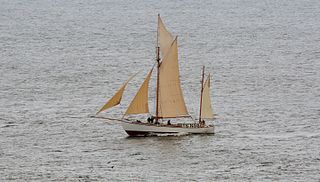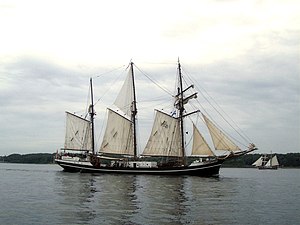
Thor Heyerdahl KStJ was a Norwegian adventurer and ethnographer with a background in biology with specialization in zoology, botany and geography.

The Kon-Tiki expedition was a 1947 journey by raft across the Pacific Ocean from South America to the Polynesian islands, led by Norwegian explorer and writer Thor Heyerdahl. The raft was named Kon-Tiki after the Inca god Viracocha, for whom "Kon-Tiki" was said to be an old name. Heyerdal's book on the expedition was entitled The Kon-Tiki Expedition: By Raft Across the South Seas. A 1950 documentary film won the Academy Award for Best Documentary Feature. A 2012 dramatized feature film was nominated for the Academy Award for Best Foreign Language Film.

The Dar Pomorza is a Polish full-rigged sailing ship built in 1909 which is preserved in Gdynia as a museum ship. She has served as a sail training ship in Germany, France, and Poland. Dar Pomorza won the Cutty Sark Trophy in 1980.

USCGC Eagle (WIX-327), formerly the Horst Wessel and also known as the Barque Eagle, is a 295-foot (90 m) barque used as a training cutter for future officers of the United States Coast Guard. She is one of only two active commissioned sailing vessels in the United States military today, along with USS Constitution which is ported in Boston Harbor. She is the seventh Coast Guard cutter to bear the name in a line dating back to 1792, including the Revenue Cutter Eagle.

A barquentine or schooner barque is a sailing vessel with three or more masts; with a square rigged foremast and fore-and-aft rigged main, mizzen and any other masts.

From its modern interpretations to its antecedents when maritime nations would send young naval officer candidates to sea, sail training provides an unconventional and effective way of building many useful skills on and off the water.

Passat is a German four-masted steel barque and one of the Flying P-Liners, the famous sailing ships of the German shipping company F. Laeisz. She is one of the last surviving windjammers.

Kruzenshtern or Krusenstern is a four-masted barque that was built in 1926 at Geestemünde in Bremerhaven, Germany as Padua. She was surrendered to the USSR in 1946 as war reparation and renamed after the early 19th-century Baltic German explorer in Russian service, Adam Johann von Krusenstern (1770–1846). She is now a Russian sail training ship.

Alexander von Humboldt is a German sailing ship originally built in 1906 by the German shipyard AG Weser at Bremen as the lightship Reserve Sonderburg. She was operated throughout the North and Baltic Seas until being retired in 1986. Subsequently, she was converted into a three masted barque by the German shipyard Motorwerke Bremerhaven and was re-launched in 1988 as Alexander von Humboldt. In 2011 the ship was taken off sail-training and sent to the Caribbean for the charter business, then she was converted to a botel.

MS Vana Tallinn was a cruiseferry owned by the Estonian ferry company Tallink and operated on the line between Kapellskär and Paldiski. She was built in 1974 by Aalborg Skibsværft AS, Aalborg, Denmark for DFDS as MS Dana Regina, and has sailed under the names MS Nord Estonia and MS Thor Heyerdahl.

NRP Sagres is a tall ship and school ship of the Portuguese Navy since 1961. As the third ship with this name in the Portuguese Navy, she is sometimes referred to as Sagres III.

STS Sedov, formerly Magdalene Vinnen II (1921–1936) and Kommodore Johnsen (–1948), is a four-masted steel barque that for almost 80 years was the largest traditional sailing ship in operation. Originally built as a German cargo ship, Sedov is today a sail training vessel, training cadets from the universities of Kaliningrad, Saint Petersburg and Astrakhan. She participates regularly in the big maritime international events as a privileged host and has also been a regular participant in The Tall Ships' Races.

Reed boats and rafts, along with dugout canoes and other rafts, are among the oldest known types of boats. Often used as traditional fishing boats, they are still used in a few places around the world, though they have generally been replaced with planked boats. Reed boats can be distinguished from reed rafts, since reed boats are usually waterproofed with some form of tar. As well as boats and rafts, small floating islands have also been constructed from reeds.

Eye of the Wind is a brigantine built in 1911 at the C. H. Lühring shipyard in Brake, Germany, originally as a topsail schooner named Friedrich.
Electa S. "Exy" Johnson was an American author, lecturer, adventurer, and sail training pioneer.

Großherzogin Elisabeth is a 1909 German sailing ship built as the San Antonio, a replacement for the 1907 freighter San Antonio which had been lost in a collision at sea.

Roald Amundsen, originally named Vilm, is a German steel-ship built on the Elbe River in 1952. Having worked in different areas, she was refitted in 1992 to 1993 as a brig and now serves as a sail training ship. During summer, she usually operates in the Baltic Sea, and usually embarks for journeys to farther destinations for winter, including several trans-Atlantic crossings.

Wyvern is a 60-foot (18 m) open sea sailing ship operated by Stavanger Maritime Museum. The ship was designed by Colin Archer on a commission from British-born Frederick Croft and was launched on 10 August 1897. She sailed under the German flag from 1909. The Norwegian newspaper editor Rolf Thommessen bought her in 1924 and renamed her Havfruen III. This name was kept by the English owners, Anne and Terrence Carr, who acquired her in 1947 and sold her to Christian-Frederick Mattner in 1970, who renamed her to the original name "Wyvern".

The First Fleet Reenactment Voyage was a project to assemble a fleet of tall ships to sail from England to Australia in a historical reenactment of the First Fleet that colonised Australia in 1788. The reenactment was first conceived in 1977 and organised to commemorate Australia's bicentenary of colonisation. Despite opposition and minimal funding from the Australian government, the project attracted the support of high-profile adventurers Thor Heyerdahl, Alan Villiers, and Sir Edmund Hillary, as well as former Australian political figures and the British Royal Family. Several corporations offered to sponsor the fleet as a whole or individual ships, and additional money was raised by selling "training crew" berths for the various legs of the voyage.

Abora is the name of several reed boats built by the German explorer Dominique Görlitz. The expeditions were inspired by previous trans-oceanic expeditions by the Norwegian explorer Thor Heyerdahl. Main aim of the Abora expeditions was to prove that a keel-less reed boat could be steered crosswise and against prevailing winds, using sideboards (leeboards) in lieu of a fixed keel. The name of the vessels was derived from the Canarian deity Abora.





















